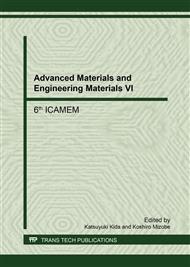[1]
M.A. Doss, G. Rajarajan, V. Thanikachalm, S. Salvanayagam, B. Sridhar, Synthesis, spectroscopic(UV-Vis, FT-IR and NMR), single crystal XRD of 3, 5-diethyl-2, 6-di(thiophen-2-yl)piperidin-4-on-1-ium picrate: A comprehensive experimental and computational study, J. Mol. Struct. 1128 (2017).
DOI: 10.1016/j.molstruc.2016.08.065
Google Scholar
[2]
D.Q. Yu, D.F. Xue, H. Ratajczak, Microscopic characteristics of hydrogen bonds of hydrated borates, Phsical B. 15 (2006) 170-176.
DOI: 10.1016/j.physb.2005.10.128
Google Scholar
[3]
A.W. Lee, C.C. Liu, Y.Z. Wei, P.L. Chen, J. Kun, Supermolecules of poly(N-isopropylacrylamide) complexating Herring sperm DNA with bio-multiple hydrogen bonding, Colloids Surf B Biointerfaces. 148 (2016) 422-430.
DOI: 10.1016/j.colsurfb.2016.09.015
Google Scholar
[4]
C. Li, S.A. Xu, F.Y. Xiao, C.F. W, Dynamic mechanical properties of chlorinated butyl rubber blends. Eur. Polym. J. 42 (2006) 2507-2514.
DOI: 10.1016/j.eurpolymj.2006.06.004
Google Scholar
[5]
X.Y. Zhao, Y.J. Cao, H. Zou, J. Li, L.Q. Zhang, Structure and dynamic properties of nitrile-butadiene rubber/hindered phenol composites, J. Appl. Polym. Sci. 123 (2012) 3696-3702.
DOI: 10.1002/app.35043
Google Scholar
[6]
D.L. Xiao, X.Y. Zhao, Y.P. Feng, P. Xiang, L.Q. Zhang, W.M. Wang, The structure and dynamic properties of thermoplastic polyurethane elastomer/hindered phenol hybrids, J. Appl. Polym. Sci. 116 (2010) 2143-2150.
DOI: 10.1002/app.31828
Google Scholar
[7]
J. P. Zeng, Y. X. Zhang, Y. Dai and S. Chen, Molecular dynamics simulation of nitrobenzene in heterocyclic ionic liquids, J. Mol. Liq. 198 (2014) 274-279.
DOI: 10.1016/j.molliq.2014.07.022
Google Scholar
[8]
A. Ammala, S.J. Pas, K.A. Lawrenec, R. Stark, R.I. Webb, A.J. Hill, Poly(m-xylene adipamide)-montmorillonite nanocomposites: effect of organo-modifier structure on free volume and oxygen barrier properties, J. Mater. Chem. 18 (2008) 911-916.
DOI: 10.1039/b712875d
Google Scholar
[9]
O.R. Pardini, J.I. Amalvy, FTIR, 1H-NMR spectra, and thermal characterization of water-based polyurethane/acrylic hybrids, J. Appl. Polym. Sci. 107 (2008) 1207-1214.
DOI: 10.1002/app.27188
Google Scholar
[10]
B. Qiao, X.Y. Zhao, D.M. Yue, L. Q. Zhang, S. Z. Wu, A combined experiment and molecular dynamics simulation study of hydrogen bonds and free volume in nitrile-butadiene rubber/hindered phenol damping mixtures, J. Mater. Chem. 22 (2012).
DOI: 10.1039/c2jm31716h
Google Scholar
[11]
M. Song, X. Y. Zhao, W. C. Tung, L. Q. Zhang and S. Z. Wu, Microstructure and dynamic properties analyses of hindered phenol AO-80/nitrile-butadiene rubber/poly(vinyl chloride): a molecular simulation and experimental study, Macromol. Theory Simul. 24 (2015).
DOI: 10.1002/mats.201400054
Google Scholar


